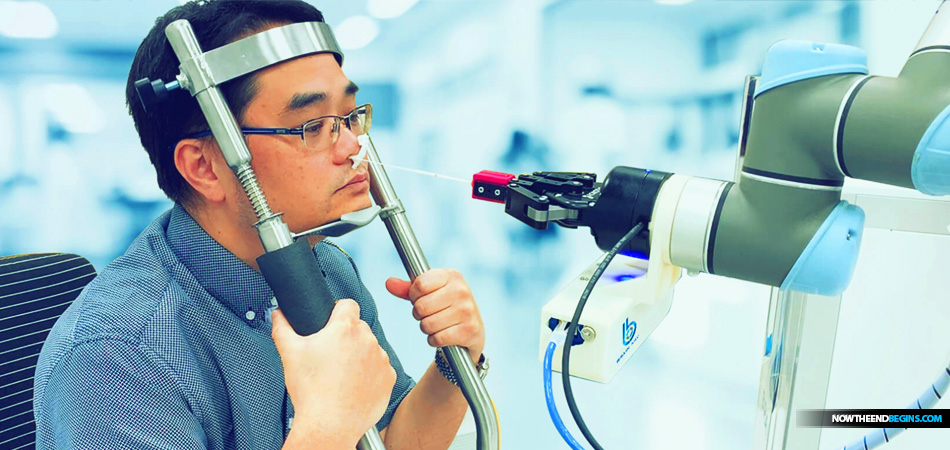
“Our founder Jerry [Chen Chieh-Hsiao] was the first one to have a nasal swab from the robot and he was terrified,” a spokesperson for Brain Navi, Zoe Lee, told The Verge.
With each new day, another unsettling and often-times frightening new nugget is released, letting us know that 2020 is not like any other year. 2020 is the year that"it" finally happened, we crossed that thin line between what life used to be like, and what it is now like. Can't say we weren't warned, because we certainly were. Nearly 6 decades of science fiction and dystopian novels set in the future should have prepared you for this. Of course, if you're a bible believer, you are already prepared.
"Behold ye among the heathen, and regard, and wonder marvellously: for I will work a work in your days, which ye will not believe, though it be told you." Habakkuk 1:5 (KJB)
A robot conducting a COVID swab test? Sure, why not? How about a robot conducting a chip insertion for your Immunity Passport? Yep, that's coming. How about a robot injecting the back of your right hand with the Mark of the Beast? It will be the only way to chip billions of people in a short time period. There's no turning back now, you're in the end times. The only question is, are you ready for what comes next? If you're not, there will be a robot standing by to assist in making the transition. Or, you can get a ticket for
Flight #777 on Titus213 Airlines. Your choice.

JOIN US AS WE WELCOME BRAIN NAVI TO THE NTEB MARK OF THE BEAST ARCHIVE
Please remain calm while the Brain Navi robot swabs your nose
FROM THE VERGE: If you’ve been tested for COVID-19 then you’ve probably experienced the unpleasantness of a nasal swab. Someone takes a long-handled cotton swab and sticks it up your nose — way up your nose — until it reaches the back of the mucus-cave that is your nasal cavity. Upon arrival they give the swab a good twirl to collect your secretions and beat a merciful retreat. I can say from personal experience that it’s a uniquely unpleasant sensation. It’s something that just feels wrong, like the opposite of scratching an itch.
That’s perhaps why I was so unsettled by the sight of this autonomous nasal swab robot developed by Taiwanese
medtech startup Brain Navi. Of all the entities I don’t want sticking cotton swabs up my nose, an industrial robot arm is pretty high on the list, right between an excitable toddler and a trained mountain gorilla. A nasal swab requires
trust.
Nevertheless, the bot exists, and Brain Navi’s case for it is more compelling than you might think. As mass-testing ramps up globally, the company argues that automating testing could reduce infections and free up medical staff to tackle more pressing work. If we can get over our first impressions of a robot wielding a cotton swab, says the company, it may benefit us all. Doctors The Verge spoke to about the machine, though, were a bit more skeptical about its chances in the real world.
First, though, let’s talk about how it all works.
To begin the procedure, a patient dons a nasal clip that the machine uses to orientate itself. They then place their head in a metal bracket similar to those used for eye examinations (gripping the handle bars like you’re riding the world’s worst rollercoaster is apparently optional). A depth-sensing camera then scans their face and measures the distance from nostril to ear canal, which Brain Navi says is a reliable proxy for the depth of the nasal cavity, and helps the robot navigate safely inside you.
The robot then retrieves a cotton swab from it base and, with torturous slowness, approaches the victim patient. It inserts the swab, twirls it, then withdraws, placing the sample in a sterile tube for transportation and analysis. You can watch it all happen below.
Let’s be clear: this does not look like fun! This looks mildly terrifying! There’s something about the slowness and inevitability of the robot’s movements that feels like an implicit threat, and the whole operation has the vibe of an alien lobotomy.
Brain Navi is well aware of how it all looks. “Our founder Jerry [Chen Chieh-Hsiao] was the first one to have a nasal swab from the robot and he was terrified,” a spokesperson for BrainNavi, Zoe Lee, told
The Verge. But she, says, it’s all a matter of familiarity. “I think people will be frightened because it’s a new thing but that’s normal. We’ve heard the feedback and are figuring out how to reduce this terrifying feeling.”
READ MORE
Get Ready For Terrifying COVID Swab Tests Given By Robots From Brain Navi
Lee says Brain Navi is in talks with Taiwan’s Taoyuan international airport about the possibility of testing the robot on incoming passengers. As she explains, this would be the perfect show-case for the machine’s benefits. “Every country wants to reopen their economy, and to reopen safely, large scale testing [at airports] might be the key,” says Lee. She says the robot can perform a swab in just two minutes and will work non-stop.
No comments:
Post a Comment